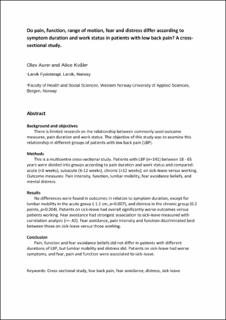| dc.contributor.author | Aure, Olav Frode | |
| dc.contributor.author | Kvåle, Alice | |
| dc.coverage.spatial | Norway | en_US |
| dc.date.accessioned | 2020-09-04T09:34:27Z | |
| dc.date.available | 2020-09-04T09:34:27Z | |
| dc.date.created | 2020-08-18T14:54:33Z | |
| dc.date.issued | 2020 | |
| dc.identifier.citation | Aure, O., & Kvåle, A. (2020). Do pain, function, range of motion, fear and distress differ according to symptom duration and work status in patients with low back pain? A cross-sectional study. European Journal of Physiotherapy, 1–8. https://doi.org/10.1080/21679169.2020.1801834 | en_US |
| dc.identifier.issn | 2167-9169 | |
| dc.identifier.uri | https://hdl.handle.net/11250/2676376 | |
| dc.description | This is an Accepted Manuscript of an article published by Taylor & Francis in European Journal of Physiotherapy on 10 Aug 2020, available online: https://www.tandfonline.com/doi/full/10.1080/21679169.2020.1801834.
Available 10 Aug 2021 | en_US |
| dc.description.abstract | Background and objectives
There is limited research on the relationship between commonly used outcome measures, pain duration and work status. The objective of this study was to examine this relationship in different groups of patients with low back pain (LBP).
Methods
This is a multicentre cross-sectional study. Patients with LBP (n = 141) between 18 and 65 years were divided into groups according to pain duration and work status and compared: acute (<6 weeks), subacute (6–12 weeks), chronic (>12 weeks), on sick leave versus working. Outcome measures: pain intensity, function, lumbar mobility, fear avoidance beliefs and mental distress.
Results
No differences were found in outcomes in relation to symptom duration, except for lumbar mobility in the acute group (−1.1 cm, p = 0.007), and distress in the chronic group (0.2 points, p = 0.004). Patients on sick leave had overall significantly worse outcomes versus patients working. Fear avoidance had the strongest association with sick leave measured with correlation analysis (r = −0.42). Fear avoidance, pain intensity and function discriminated best between those on sick leave versus those working.
Conclusion
Pain, function and fear avoidance beliefs did not differ in patients with different durations of LBP, but lumbar mobility and distress did. Patients on sick leave had worse symptoms, and fear, pain and function were associated to sick leave. | en_US |
| dc.language.iso | eng | en_US |
| dc.subject | cross-sectional study | en_US |
| dc.subject | low back pain | en_US |
| dc.subject | fear avoidance | en_US |
| dc.subject | distress | en_US |
| dc.subject | sick leave | en_US |
| dc.title | Do pain, function, range of motion, fear and distress differ according to pain duration and work status in patients with low back pain? A cross-sectional study | en_US |
| dc.type | Peer reviewed | en_US |
| dc.type | Journal article | en_US |
| dc.description.version | acceptedVersion | en_US |
| dc.subject.nsi | VDP::Medisinske Fag: 700::Helsefag: 800::Fysioterapi: 807 | en_US |
| dc.source.pagenumber | 8 | en_US |
| dc.source.journal | European Journal of Physiotherapy | en_US |
| dc.identifier.doi | 10.1080/21679169.2020.1801834 | |
| dc.identifier.cristin | 1823876 | |
| cristin.ispublished | true | |
| cristin.fulltext | postprint | |
| cristin.qualitycode | 1 | |
